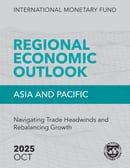This web page presents information about the work of the IMF in Vietnam, including the activities of the IMF Resident Representative Office. Additional information can be found on the Vietnam and IMF country page, including IMF reports and Executive Board documents that deal with Vietnam.
Vietnam: At a Glance
- Current IMF membership: 191 countries
- Vietnam joined the Fund on September 21, 1956; Article VIII
- At a Glance—Vietnam and the IMF
- Quota: SDR 460.70 million
- Outstanding Purchases and Loans: PRGF arrangements SDR 74.52 million
- The last Article IV Executive Board Consultation was on August 30, 2023
Vietnam and the IMF
No results found. Either there was an error with the web service or there is no data returned by the web service.
Regional Economic Outlook: Asia and Pacific
October 24, 2025

Navigating Trade Headwinds and Rebalancing Growth
Economies in the Asia-Pacific region have been resilient so far in 2025. Nevertheless, higher US tariffs will likely reduce external demand and eventually weigh on growth. Greater regional integration and structural reforms will be critical for sustainable growth.
Read the Report




